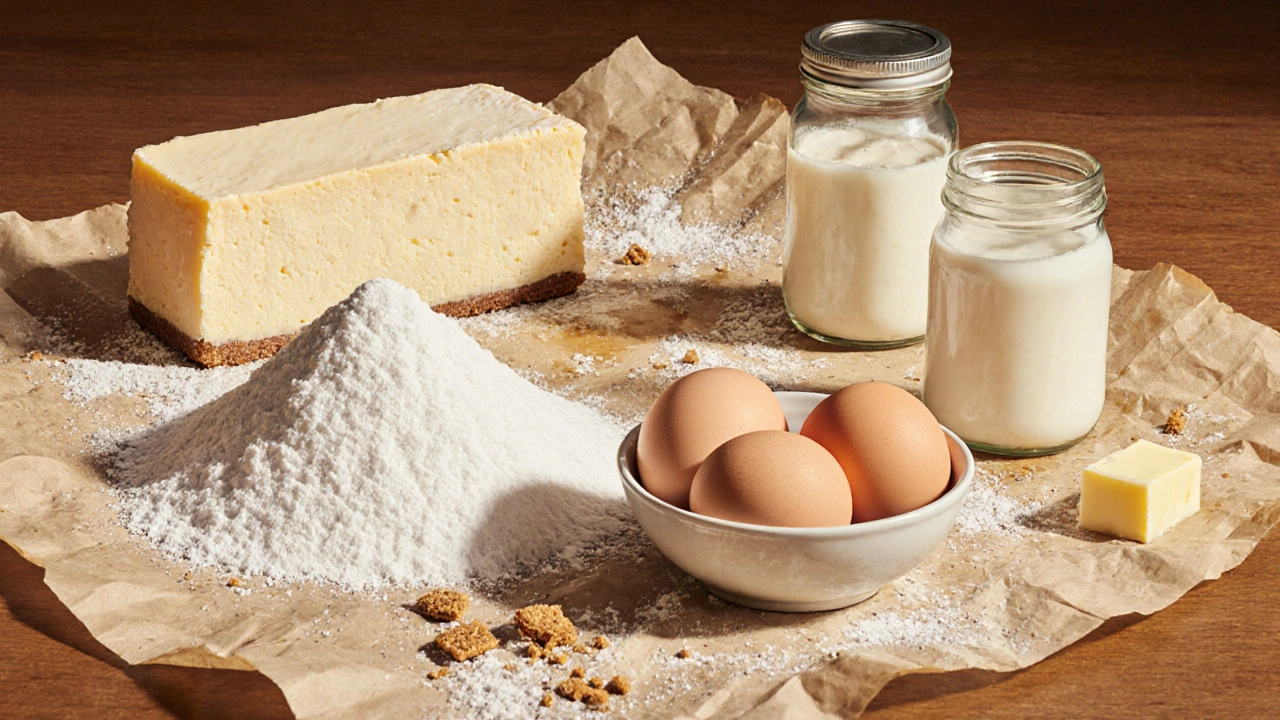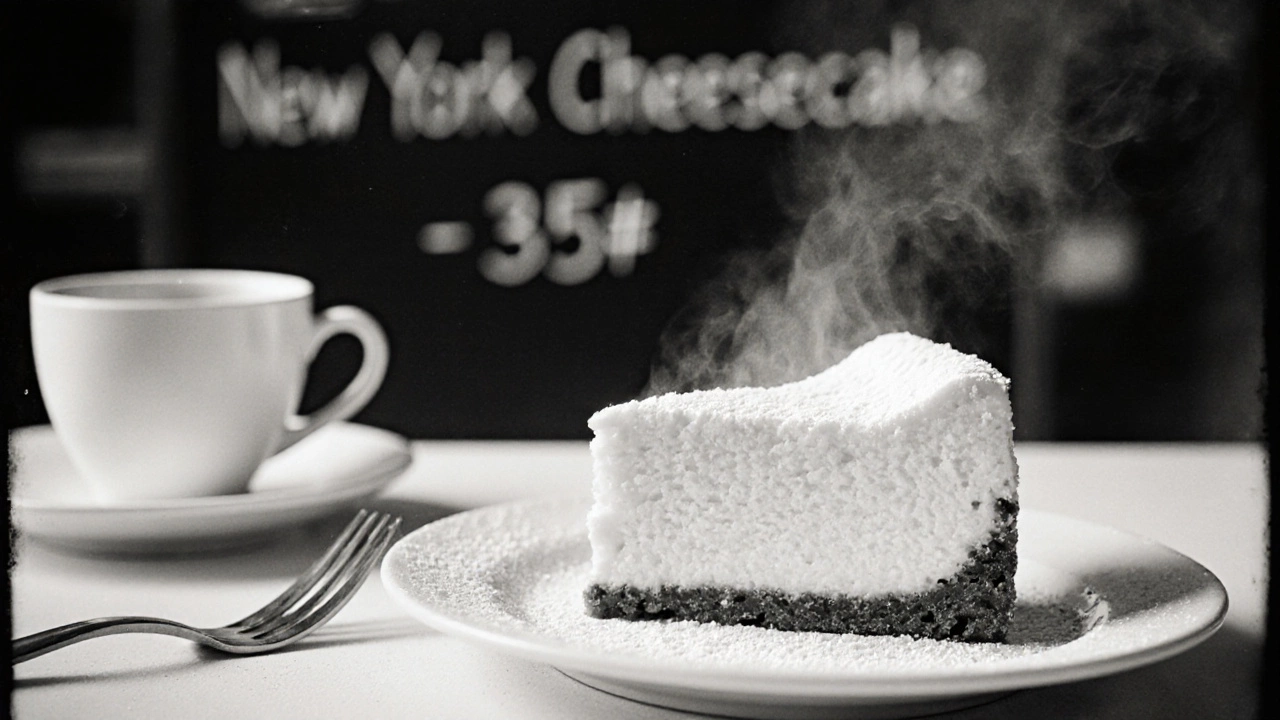New York Cheesecake Ingredient Calculator
Get Your Perfect Recipe
Calculate precise ingredient measurements for authentic New York cheesecake based on your pan size and serving needs.
New York cheesecake isn’t just a dessert-it’s a texture, a memory, a slice of history baked into a springform pan. If you’ve ever taken a bite and wondered why it’s so rich, so dense, so perfectly smooth, the answer isn’t magic. It’s a handful of simple ingredients, used the right way. No fancy gadgets. No obscure additives. Just cream cheese, eggs, sugar, and a crust that holds it all together like a quiet promise.
The Core Four: What Actually Goes Into the Batter
At its heart, New York cheesecake is built on four ingredients that rarely change across decades of recipes. The first is cream cheese. Not soft cheese. Not cottage cheese. Not mascarpone. Full-fat, brick-style cream cheese-like Philadelphia or its equivalents-is non-negotiable. It needs to be cold when you start, but room temperature before you mix. If it’s too cold, you’ll get lumps. Too warm, and the texture turns grainy. The fat content matters: real New York cheesecake uses cream cheese with at least 33% milk fat. Lower-fat versions? They make a cake that’s more like a custard with identity issues.
The second is sugar. Granulated white sugar, not powdered. Powdered sugar dissolves too fast and can make the batter too airy. You want the sugar to dissolve slowly as the cake bakes, helping create that dense, velvety crumb. Most recipes call for 1 to 1.5 cups, depending on how sweet you like it. But here’s the trick: the sugar isn’t just for taste. It stabilizes the eggs and helps the cheesecake hold its shape when it cools.
The third is eggs. Not just any eggs-large, fresh ones. You need about 3 to 4, depending on the size of your cream cheese block. The yolks add richness. The whites give structure. But you don’t whip them. You don’t fold them in like meringue. You just stir them in gently, just until combined. Overmixing introduces air, and air means cracks. That’s why you see professional bakers tap the bowl on the counter before pouring the batter into the crust. It pops the bubbles before they can ruin the surface.
The fourth is sour cream. This is what sets New York cheesecake apart from every other kind. Not heavy cream. Not Greek yogurt. Real, full-fat sour cream. About half a cup. It adds moisture, tang, and a slight softness that keeps the cake from being chalky. It’s the secret to that melt-in-your-mouth finish. Some recipes swap it for heavy cream, but that makes it richer, not better. Sour cream balances the fat. It’s the quiet hero.
The Crust: More Than Just a Base
The crust isn’t an afterthought. It’s the foundation. Traditional New York cheesecake uses a graham cracker crust. Not digestive biscuits. Not shortbread. Graham crackers. The kind with cinnamon and a bit of honey. Crushed fine, mixed with melted butter-usually 6 tablespoons for a 9-inch pan-and pressed firmly into the bottom of the pan. No fancy tools needed. Just the back of a measuring cup. You want it tight. If it’s loose, the crust falls apart when you cut into it.
Some people add a pinch of salt. Others add a tablespoon of sugar. Both help. Salt cuts the sweetness. Sugar gives it a little crispness. But don’t go overboard. The crust should taste like a toasted cookie, not a dessert on its own. The filling should be the star.
There’s one thing you won’t find in a true New York cheesecake: flour. No cornstarch. No flour. No gelatin. Just eggs, cream cheese, sugar, and sour cream. That’s it. That’s what makes it so dense. No thickeners. No tricks. Just the natural setting power of eggs and fat.

What’s Missing: The Myths Debunked
There are a lot of stories about what makes New York cheesecake special. Some say it’s the water bath. Others say it’s the oven temperature. Some even claim it’s the type of springform pan. All of those matter-but they’re not ingredients. They’re techniques.
What you won’t find in a real New York cheesecake:
- Vanilla extract (some use it, but purists skip it to let the cheese shine)
- Lemon zest or juice (that’s a Florida or Italian twist)
- Whipped cream folded in (that’s a no-bake version)
- Heavy cream instead of sour cream (that’s a French-style cheesecake)
- Chocolate swirls or fruit swirls (those are toppings, not the real thing)
True New York cheesecake is bare. It’s elegant in its simplicity. The flavor comes from the cream cheese itself-slightly tangy, deeply dairy-rich. The crust adds crunch. The sour cream adds silk. And the eggs? They turn it all into something that holds its shape but melts on your tongue.
Why It’s Called ‘New York’
The name didn’t come from a chef in Manhattan. It came from a deli. In the 1920s, Arnold Reuben, owner of Reuben’s Delicatessen, started making a heavier, richer cheesecake using cream cheese instead of the traditional farmer’s cheese used in Eastern European recipes. It was served in slices, not as a whole cake. People loved it. By the 1940s, restaurants like Junior’s in Brooklyn were serving it with a side of coffee and a fork. That’s when it became a New York institution.
It’s not about the city. It’s about the texture. The density. The way it doesn’t collapse when you cut it. That’s what makes it New York.

How to Get It Right: A Few Pro Tips
If you’ve tried making this before and ended up with cracks, a soggy crust, or a cake that’s too soft, here’s what you probably missed:
- Let the cream cheese sit out for 2 hours before mixing. Cold cream cheese doesn’t blend-it tears.
- Use a stand mixer or hand mixer on low. Don’t whip it. Mix just until smooth.
- Don’t open the oven door for the first 45 minutes. Temperature drops cause cracks.
- Turn off the oven when the center still jiggles slightly. Let it sit inside for an hour with the door cracked. The residual heat finishes cooking it gently.
- Chill it for at least 8 hours, preferably overnight. This isn’t optional. It needs time to set properly.
And here’s the most important tip: don’t top it with berries or chocolate sauce on the day you bake it. Wait until you’re ready to serve. The moisture will soften the crust. A plain slice with a dusting of powdered sugar? That’s how it’s meant to be eaten.
What Makes It Different From Other Cheesecakes
Italian cheesecake uses ricotta. It’s light, grainy, and bright. Japanese cheesecake is airy, soufflé-like, and baked in a water bath with lots of egg whites. New York is the opposite. It’s heavy. It’s dense. It’s meant to be eaten slowly, with a fork, and no apologies.
Chicago-style cheesecake uses more cream cheese and less sour cream. It’s richer, but also drier. New York strikes a balance. It’s not the lightest. It’s not the richest. It’s the most balanced.
And that’s why, after nearly 100 years, people still line up for it.
Can I use low-fat cream cheese for New York cheesecake?
No. Low-fat or reduced-fat cream cheese doesn’t have enough fat to set properly. The result is a cake that’s too soft, watery, or grainy. New York cheesecake relies on fat for structure and texture. Stick with full-fat, brick-style cream cheese-no shortcuts.
Why does my cheesecake crack on top?
Cracks happen when the cake overbakes or cools too quickly. The surface dries out and pulls apart. To prevent this, don’t overmix the batter, don’t open the oven door early, and let the cake cool slowly in the turned-off oven with the door cracked open. The jiggle test is key: the center should still wobble slightly when you shake the pan.
Can I make New York cheesecake without a springform pan?
You can, but it’s not ideal. A springform pan lets you release the sides without flipping the cake. If you use a regular cake pan, you’ll have to line it with parchment paper and lift the cake out carefully-risking cracks or breakage. A springform is the standard for a reason.
How long does New York cheesecake last?
Stored in the fridge, it lasts up to 5 days. Wrap it tightly in plastic or keep it in an airtight container. It doesn’t freeze well-the texture turns grainy after thawing. Best eaten fresh.
Is sour cream necessary, or can I skip it?
Sour cream isn’t optional if you want authentic New York texture. It adds moisture and tang that balances the richness of the cream cheese. Without it, the cake tastes flat and dense in a bad way. If you don’t have sour cream, you can substitute with full-fat Greek yogurt, but it won’t be the same.